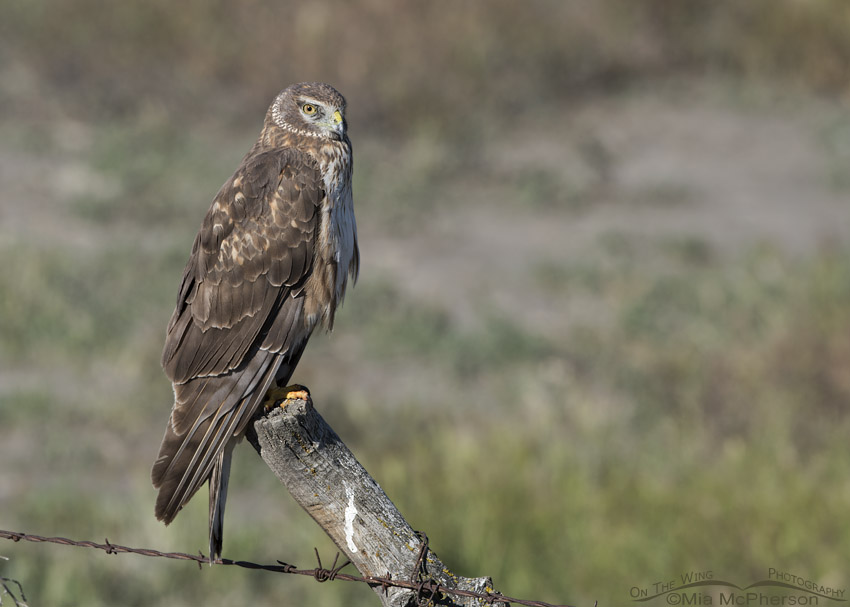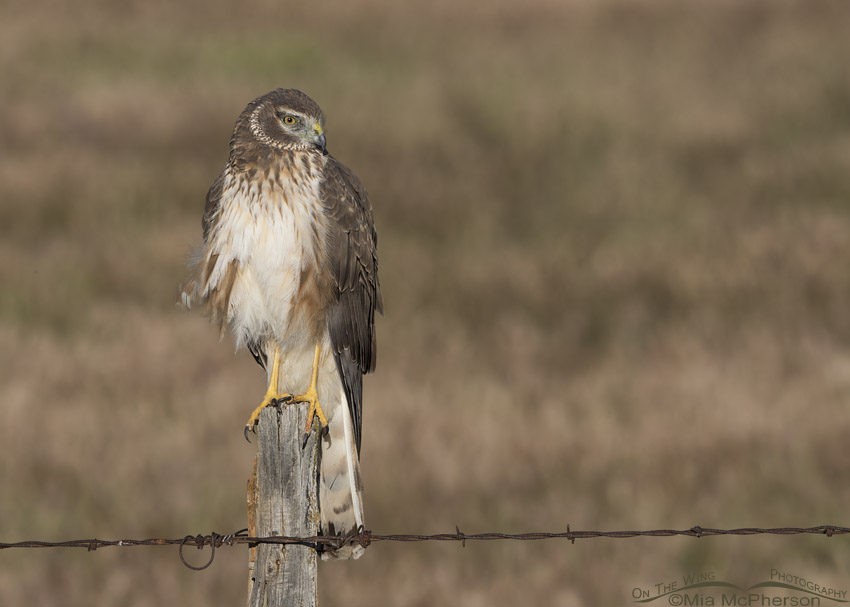 First Spring Northern Harrier male perched – Nikon D810, f8, 1/640, ISO 400, Nikkor 500mm VR with 1.4x TC, natural light, not baited
First Spring Northern Harrier male perched – Nikon D810, f8, 1/640, ISO 400, Nikkor 500mm VR with 1.4x TC, natural light, not baited
There was a very cooperative first spring male Northern Harrier in a location where I photographed Short-eared Owls last year in northern Utah and for two months I could reliably see and photograph it frequently. I started photographing it on April 6, 2016, which is when this photo was taken from the shoulder of a road in Box Elder County.
 First Spring male Northern Harrier in golden morning light – Nikon D810, f8, 1/250, ISO 400, Nikkor 500mm VR with 1.4x TC, natural light, not baited
First Spring male Northern Harrier in golden morning light – Nikon D810, f8, 1/250, ISO 400, Nikkor 500mm VR with 1.4x TC, natural light, not baited
Some times the young harrier would be on the wrong side of the road to have good light on it but most often it was on the west side of the road where I would often have beautiful, warm morning light fall on the bird.
This Northern Harrier seemed to have its favorite perches in an area of only a couple of hundred yards along the road. This photo was taken at at 7:02 a.m. on May 3, 2016…
 Preening first Spring male Northern Harrier – Nikon D810, f6.3, 1/800, ISO 400, -0.3 EV, Nikkor 500mm VR with 1.4x TC, natural light, not baited
Preening first Spring male Northern Harrier – Nikon D810, f6.3, 1/800, ISO 400, -0.3 EV, Nikkor 500mm VR with 1.4x TC, natural light, not baited
And on May 12, 2016 at at 7:02 a.m. I found the harrier on the exact same perch. I photographed the harrier from slightly different angles on these two occasions.
 Close up of a first Spring male Northern Harrier – Nikon D810, f13, 1/500, ISO 250, -0.7 EV, Nikkor 500mm VR with 1.4x TC, natural light, not baited
Close up of a first Spring male Northern Harrier – Nikon D810, f13, 1/500, ISO 250, -0.7 EV, Nikkor 500mm VR with 1.4x TC, natural light, not baited
The sub adult harrier was not skittish and with a slow approach there were times I could get frame filling images of it from the road without it showing any signs of distress. At times it would glance in my direction and then preen its feathers. This photo was taken May 26, 2016.
 First Spring male Northern Harrier staring at me – Nikon D810, f13, 1/250, ISO 250, Nikkor 500mm VR, natural light, not baited
First Spring male Northern Harrier staring at me – Nikon D810, f13, 1/250, ISO 250, Nikkor 500mm VR, natural light, not baited
And there were times I took off my teleconverter so I could fit the entire bird in the frame as I composed my images. This photo was also taken on May 26, 2016 just a few minutes after the image above.
In this photo I can see that the primaries; also known as flight feathers, look more grayish than the secondaries next to them which is one of the ID features I used to determine that this first spring harrier is a male.
 Northern Harrier at the end of May 2016 – Nikon D810, f14, 1/400, ISO 320, -0.7 EV, Nikkor 500mm VR with 1.4x TC, natural light, not baited
Northern Harrier at the end of May 2016 – Nikon D810, f14, 1/400, ISO 320, -0.7 EV, Nikkor 500mm VR with 1.4x TC, natural light, not baited
What does “first spring” mean? Well it means this harrier hatched and fledged in 2015 and that it was seeing its first spring in 2016. This photo was taken on May 30, 2016.
 Male Northern Harrier in his first Spring – Nikon D810, f14, 1/400, ISO 200, -1.0 EV, Nikkor 500mm VR, natural light, not baited
Male Northern Harrier in his first Spring – Nikon D810, f14, 1/400, ISO 200, -1.0 EV, Nikkor 500mm VR, natural light, not baited
After the 30th of May last year my sightings of this young male Northern Harrier became less frequent but I was spending more time searching for Short-eared Owl chicks at that point and less looking for him. I enjoyed the time I spent photographing this hawk in April and May of last year and loved having him in my viewfinder.
This spring I have missed seeing and photographing this cooperative Northern Harrier but often think of him when I go past these fence posts when I am on that section of the road.
Life is good.
Mia
All of these images were taken from within a vehicle that was being used as a mobile blind. The road has plenty of traffic including large trucks with horse and cattle trailers and semis hauling big loads. The harrier was used to vehicles so using a mobile blind was the best choice for the bird’s comfort.
Click here to view more of my Northern Harrier photos plus facts and information about this species.


I’ve never heard of or seen this type of bird. Very beautiful. Is it a type of hawk?
Terrific study and your narrative is wonderful. Thanks Mia.
Such a beauty. I hope that where-ever he is, his second spring is going well.
Wonderful images and interesting information, Thanks!
I like this series and appreciate the bird’s cooperation in letting you get so msny good shots. I thought eye color was a clue to the bird’s age…didn’t realize they could be sexed by it…
I like this series and appreciate the bird’s cooperation in letting you get so msny good shots. I thought eye color was a clue to the bird’s age…didn’t realize they could be sexed by it…
The pale eyes are the diagnostic characteristic of a male.
Wonderful series of photos.
Beautiful images Mia. Happy Mothers day to you.
Lovely series of images Mia.